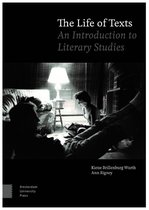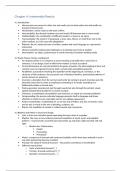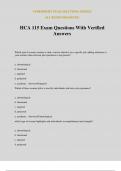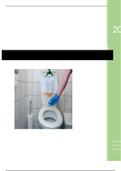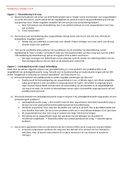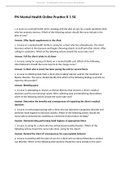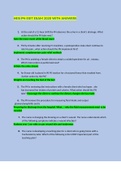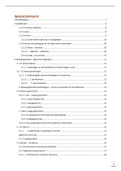Chapter 4: Intermedial Poetics
4.1 Introduction
Literary texts are present in other arts and media, just as these other arts and media are
present in literary texts
Novelisation: novels made on the basis of films
Intermediality: the dynamic between arts and media OR between two or more media
Multimediality: the combination of different media in a movie or an opera
Transmediality: the result of ‘transposing’ a story, idea, theme, or motif from one to the
other medium, as is the case with adaptations
Rhetoric: the art, study and uses of written, spoken and visual language as a persuasive
instrument
Literary creativity continuously challenges us to develop new tools of analysis
Intermedium: an object, performance or event hovering in-between existing media
4.2 Poetic Theory, Poetry, and Beyond
To compose poetry is co compress as much meaning as possible into a word, line or
sentence; it is to design a text in which form matters as much as content
Formal dimensions are not just limited to the genre of poetry: the intermingling of form and
content is just as important in prose texts, commercials and political speeches
Parallelism: a procedure involving the repetition of the beginning of a sentence, or the
structure of that sentence: the successive use of identical rhythms, grammatical patterns of
words, phrases or sentences
Inversion: a deviation from the normal word order by turning it around; inversion puts the
adverbial clause first in order to emphasize something or to render something in a
deliberately stately or formal style
Poetry generates meaning not just through sounds but also through the printed, visual,
spatial and geometrical patterns it creates on paper
Chiasmus: a combination of parallelism and inversion, or simply an inverted parallelism
Foregrounding: the process whereby language presents itself as language and draws
attention to itself, its own materiality and its own oblique appearance
Poetry is potentially a multimedial art: an art not only of letters, but also of sounds, music
and an arts as visual as the arts of painting, sculpture, etc.
Rhyme: the repetition of sounds or related vowels and consonants
4.3 Rhythm and Metre in Sound and Image
Lyric: a short non-narrative poem expressing the inner state of a speaker
Rhythm: the more or less ordered, perceived repetition of visual, aural, and palpable
patterns – loud and soft, accented and unaccented, up and down, light and dark, left and
right
o Rhythm has 3 dimensions:
Kinetic
Fluctuating
Perceptual
Metre: a sequence of stressed and unstressed syllables which have been ordered in such a
way that metrical feet become manifest
Prosody: the study of metrical structure – the practice and theory of versification
Different metrical feet
o Iamb: unstressed stressed (^_)
o Trochee: stressed unstressed (_^)
o Spondee: stressed stressed (_ _)
4.1 Introduction
Literary texts are present in other arts and media, just as these other arts and media are
present in literary texts
Novelisation: novels made on the basis of films
Intermediality: the dynamic between arts and media OR between two or more media
Multimediality: the combination of different media in a movie or an opera
Transmediality: the result of ‘transposing’ a story, idea, theme, or motif from one to the
other medium, as is the case with adaptations
Rhetoric: the art, study and uses of written, spoken and visual language as a persuasive
instrument
Literary creativity continuously challenges us to develop new tools of analysis
Intermedium: an object, performance or event hovering in-between existing media
4.2 Poetic Theory, Poetry, and Beyond
To compose poetry is co compress as much meaning as possible into a word, line or
sentence; it is to design a text in which form matters as much as content
Formal dimensions are not just limited to the genre of poetry: the intermingling of form and
content is just as important in prose texts, commercials and political speeches
Parallelism: a procedure involving the repetition of the beginning of a sentence, or the
structure of that sentence: the successive use of identical rhythms, grammatical patterns of
words, phrases or sentences
Inversion: a deviation from the normal word order by turning it around; inversion puts the
adverbial clause first in order to emphasize something or to render something in a
deliberately stately or formal style
Poetry generates meaning not just through sounds but also through the printed, visual,
spatial and geometrical patterns it creates on paper
Chiasmus: a combination of parallelism and inversion, or simply an inverted parallelism
Foregrounding: the process whereby language presents itself as language and draws
attention to itself, its own materiality and its own oblique appearance
Poetry is potentially a multimedial art: an art not only of letters, but also of sounds, music
and an arts as visual as the arts of painting, sculpture, etc.
Rhyme: the repetition of sounds or related vowels and consonants
4.3 Rhythm and Metre in Sound and Image
Lyric: a short non-narrative poem expressing the inner state of a speaker
Rhythm: the more or less ordered, perceived repetition of visual, aural, and palpable
patterns – loud and soft, accented and unaccented, up and down, light and dark, left and
right
o Rhythm has 3 dimensions:
Kinetic
Fluctuating
Perceptual
Metre: a sequence of stressed and unstressed syllables which have been ordered in such a
way that metrical feet become manifest
Prosody: the study of metrical structure – the practice and theory of versification
Different metrical feet
o Iamb: unstressed stressed (^_)
o Trochee: stressed unstressed (_^)
o Spondee: stressed stressed (_ _)

